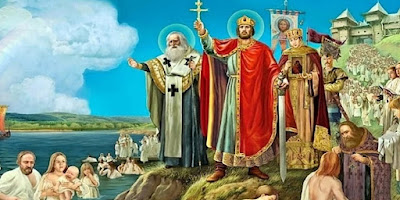According to a monk named Nestor, who wrote Account about the Life and Martyrdom of the Blessed Passion Bearers Boris and Gleb, they were their father's favorites. Boris ruled the town of Rostov, and Gleb ruled Murom. Boris was said to have been Vladimir's heir apparent, although not his eldest. When Vladimir died, the real trouble started.
The eldest son, Sviatapolk, declared himself Grand Prince of Kyiv. Boris had been on campaign with the army, and his friends tried to get him to go to Kyiv to challenge Sviatapolk, but Boris said “I will not raise my hand against my brother, who is even older than I, and whom I should respect as my father!” Sviatapolk was not so interested in avoiding civil or familial strife, however, and had Boris assassinated while sleeping. Well, almost: he was stabbed, but while the body was being transported to Kyiv in a bodybag, those escorting it realized he was still breathing inside, and they thrust a sword into it.
Word had not yet reached Gleb that their father was dead. Sviatapolk sent a message that Vladimir was on his deathbed, causing Gleb to rush to his side, suspecting no treachery. Another brother, Yaroslav, learned about Sviatapolk and told Gleb that Boris is dead and to not meet with Sviatapolk, but the warning didn't help: while praying for Boris, Gleb's own cook slits his throat with a kitchen knife.
Because the two were faced with potential violence and did not meet it with violence, they were declared martyrs for the Faith. They were canonized by the Eastern Orthodox Church in 1071. They were interred at the Vyshhorod Cathedral. The Roman Catholic Church canonized them in 1724. Many Russian and Ukrainian churches were named for them.
Their Christianity, so soon after their father converted the nation, was surprisingly steadfast. If Vladimir had not done that, how would they have been raised differently, one wonders. What was Slavic paganism like? Let's talk about that tomorrow.










